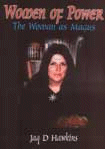
Women of Power: The Woman As Magus
, by Jaq D. Hawkins
CapallBann Publishing, 186163241X, (153 pp. including appendices, bibliography and index), 2006
“…most of the books on ceremonial magic continue to be written by men, despite significant numbers of female members existing in ceremonial magical Orders.”1
Jaq D. Hawkins is the author of several books on magick. Her first, Understanding Chaos Magic, remains among the most straightforward introductions to the subject. Her latest book, Women of Power, tackles the subject of the woman as magus, what it means and how it plays out in practice.
The book opens with a history of the woman in ceremonial magick, however, the history presented is lacking; broad strokes are often used in place of a more thorough look at the events as they occurred. For example, Hawkins writes that “[h]istorically, magic in the Western world was a man’s game and magical Orders were created and dominated by them…leadership roles in these groups continued to be filled by men”.2 This is not strictly true. Madame Blavatsky co-founding the Theosophical Society and effectively serving as its figurehead for the rest of her life. The role the Golden Dawn played in recognizing women as competent magicians in their own right by admitting women and men as equals is not mentioned, nor is Florence Farr’s term as the Praemonstratrix.
Hawkins is better in her criticism of modern magicians, where she notes that there are many women who write books on Wicca and neo-paganism, but few on alchemy, hermeticism, and kabbalah, though she has met many practitioners in her time (this resonates with what I’ve encountered as well).
Indeed, the bulk of the material is derived from Hawkins’ personal experience, and anecdotes from other, unnamed, women. Unfortunately, the writing suffers at times, lacking a broader perspective on the topics covered.
Many of the sections on techniques for women frustrated me. I understand that Hawkins’ intent was to empower women with techniques all their own, but they tended to come across as either superficial or stereotypical when they need not have been.
Enchantment is defined as “the imposition of one’s consciousness on another”, and Hawkins claims that it is “in the nature of the female to beguile”. 3 Yet the practices she details correlate also to the sort of charms found in young men of a certain age and temperament. The differences in technique are slight and mostly determined by cultural expectations – why pretend this is a power one sex uses over another? Both use it to great effect on both genders (among others).
Further, she writes: “Perhaps the strongest magic that a woman does wield happens when she becomes a mother.” 4 As a deliberately childless woman myself, I take great exception to this proclamation. It’s clear that Hawkins finds potency in her role as mother, but blanketing motherhood as a woman’s highest and “strongest magic” severely undermines those who find fulfilment in other modes. It leads me to wonder if she feels fatherhood is the “strongest magic” for a man, and if not, what her argument for this reasoning might be. It’s a shame these ideas are not developed in more depth.
Where Hawkins’ Women of Power is personal reflection on her experience in modern occulture, Mary K. Greer’s Women of the Golden Dawn is a biographical study of four specific women (Maud Gonne, Moina Bergson Mathers, Annie Horniman and Florence Farr). Yet, in general, the role of women in ceremonial magick has not been much explored, and this is a topic that certainly merits attention. Hopefully Hawkins’ Women of Power will serve to encourage more on this theme.








